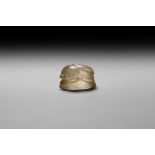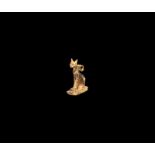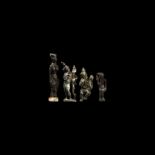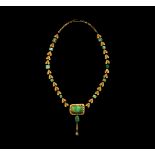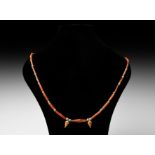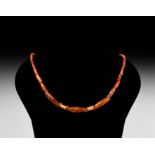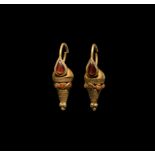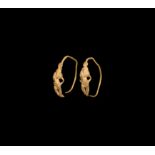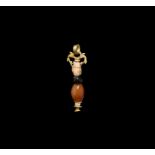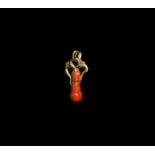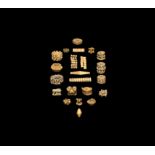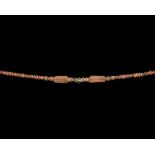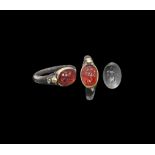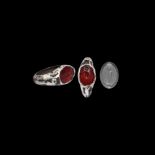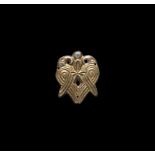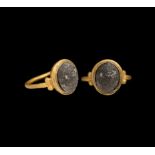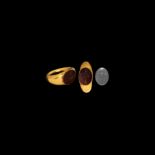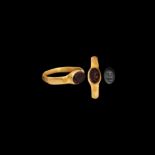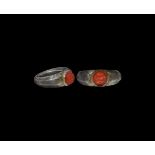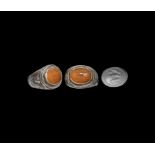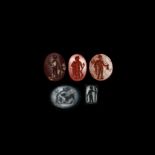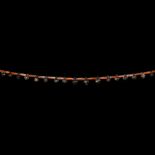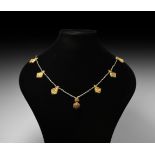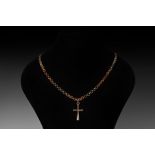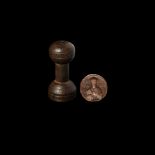Filtered by:
- Category
- List
- Grid
A subscription to the Price Guide is required to view results for auctions ten days or older. Click here for more information
6th-4th century BC. A carved rock crystal scarab with detailing to the carapace, legs and head; pierced for suspension.14.3 grams, 27mm (1"). Prop...
Egyptian Gold Cat Amulet
Third Intermediate Period, 1069-702 BC. A gold amulet of Bastet in feline form sitting on a rectangular base; suspension loop to the back.Cf. Andr...
3rd century BC-2nd century AD. A mixed group of four silver statuettes comprising: a female figure with broad hips and a headdress standing on a m...
2nd century BC-3rd century AD. An assemblage of gold necklace elements comprising: twenty-four heart-shaped leaves modelled in the half round; ten...
Hellenistic Bead Necklace
2nd-1st century BC. A restrung necklace of cylindrical carnelian beads with turquoise-coloured oblate glass spacers, centrepiece of two gold dangl...
Hellenistic Bead Necklace
2nd-1st century BC. A restrung necklace of fusiform carnelian beads with oblate carnelian beads between and two double-waisted spool-shaped gold b...
2nd-1st century BC. A pair of gold earrings, each with penannular hoop above conical pendant with pyramid granulation finial, teardrop-shaped plaq...
2nd-1st century BC. A matched pair of gold earrings, each a wire hoop with applied figure of Eros standing nude with hands on his hips.Cf. Higgins...
5th-3rd century BC. A gold drop pendant with a pair of dolphins flanking the suspension hoop, beads including agate, pearl and carnelian.2.42 gram...
5th-3rd century BC. A gold amphora-type pendant comprising a coral bead formed as an amphora, gold cap and scrolled handles formed as leaping dolp...
Mainly 1st millennium BC. A mixed group of gold beads and spacers with ribbing, granulation and other ornament.See The British Museum, museum numb...
7th century BC. A substantial restrung necklace of amber beads, mainly biconvex and spherical types, with eight gold filigree collars wrapped arou...
1st century BC-1st century AD. A silver ring with tapering D-section hoop and gold oval-shaped bezel, holding a garnet cabochon with intaglio desi...
1st century BC-1st century AD. A carnelian cabochon with intaglio design of Eros, with small wings and bow, held in a later silver ring with bifac...
4th century BC. A silver-gilt mount of two opposed eagles with hooked beaks, the parcel-gilding providing accents and details to the two birds; th...
3rd-4th century AD. A gold finger ring with dished cell to the bezel, four granules flanking the attachment points, inset aqua glass cabochon.Cf. ...
Roman Gold Ring with Salus
1st-2nd century AD. A gold hollow-formed finger ring with inset carnelian gemstone, intaglio figure of Salus standing, holding a patera in one han...
3rd century AD. A gold finger ring with facetted hoop, ellipsoid cell to the bezel with inset carnelian gemstone, intaglio image of a kantharos; a...
3rd century AD. A silver ring with facetted hoop and shoulders, octagonal bezel with inset jasper gemstone, intaglio advancing lion.Cf. Ruseva-Slo...
2nd-3rd century AD. A silver ring with D-section hoop, expanding at the shoulders to an oval-shaped bezel with applied granules and tiered setting...
Mainly 2nd-3rd century AD. A mixed group of carnelian and nicolo ellipsoid and rectangular gemstones with intaglio motifs of Olympian gods, includ...
Roman Figure of a Lobster
1st-3rd century AD. A high-relief ceramic lobster figure on an integral ellipsoidal base, with lower end of tail curled beneath the body and detai...
Roman Glass Bead Necklace
3rd-4th century AD. A restrung necklace composed of spherical dark glass beads decorated with pale dots, D-section loop to the top, interspersed w...
Byzantine Gold Pendant Necklace
6th-9th century AD. A restrung necklace of pearl seed-beads with sheet gold dangles: five lozengiform with floral motif and one similar with addor...
Byzantine Gold Fretwork Earrings
6th-7th century AD. A matched pair of gold earrings, each an elliptical hoop with granulated collar, openwork discoid plaque of vine tendrils with...
10th-13th century AD. A silver cruciform D-section pendant with suspension loop; chain with D-section links.59.3 grams, 45.5cm (18"). From an Esse...
15th century AD or later. A bronze stamp seal with domed body, cylindrical stem and squat spherical handle; the lower body decorated with a circum...
10th-12th century AD. A terracotta flask with rounded body and wide mouth flanked by pierced lugs to the shoulders; band of ropework ornament surr...
Byzantine Bird Amulet Collection
6th-10th century AD. A group of four carved onyx and agate pendants comprising: two bifacial amphora-shaped types with addorsed bird-heads at the ...
Old Babylonian Female Figure
2nd millennium BC. A ceramic figure modelled as a nude female, head inclined slightly to the right, hands clasped at the chest, hair dressed in bu...
6th-4th century BC. A silver discoid bowl with flared rim and prominent raised central boss surrounded by circles; at the external base a double c...
2nd-early 1st millennium BC and later. A necklace composed of carnelian annular and facetted polygonal bicone beads and silver facetted beads, eac...
2nd-early 1st millennium BC. A restrung necklace composed of carnelian beads and biconvex silver beads, with four lozengiform silver pendants and ...
24th-21st century BC. A necklace composed of silver biconvex and spherical beads, with notched stone beads between; restrung with later clasp.See ...
Elamite Bead Necklace
2nd millennium BC. A restrung necklace of tubular carnelian beads with biconvex lapis lazuli spacers and blue glass seed beads, centrepiece of two...
1st millennium BC. A restrung designer necklace string of graduated glass and stone beads of various shapes and colours in reds, greens, blues and...
6th-4th century BC. A silver pendant shaped as birds with large bodies and small heads, pierced beads for eyes, the main cells filled with bitumen...
6th-4th century BC. A bifacial silver pendant shaped as two facing birds or ducks, with gilt eyes and body with two miniature versions of the pair...
6th-4th century BC. A bifacial silver pendant shaped as two facing birds with large circular gilt eyes, heart-shaped stone between the heads, hatc...
Achaemenid Silver Duck Pendant
6th-4th century BC. A silver pendant shaped as a duck or bird with wings folded along the back, head reclined between the folds of the wings; deta...
9th-8th century BC. A silver bracelet with flat-section penannular body, flared centre with recessed cell running almost the full length of the ou...
Bactrian Tripartite Kohl Pot
3rd-2nd millennium BC. A rectangular-section limestone kohl pot, one face carved with a lotus flower motif within a roundel, the other with an exp...
8th-7th century BC. An agate stamp seal in the form of a human head, the reverse with the tree of life flanked by quadrupeds, eight-pointed star a...
Jemdet Nasr Bull Amulet
4th-3rd millennium BC. A carved jasper amulet in the form of a recumbent bull with legs tucked beneath the body, head held aloft and forwards, rec...
Jemdet Nasr Period Bird Pendant
4th-3rd millennium BC. An Uruk or Jemdet Nasr Period carved stone pendant in the shape of a bird in flight, wings outstretched, forked tail, head ...
2nd-1st century BC. A Hellenistic gold amphora-shaped pendant; body composed of hollow-formed spheres decorated with granulated clusters; the shou...
6th-4th century BC. A matched pair of gold crescent earrings, each with panels of applied granules, cells with inset teardrop cabochons, stud beze...
11th-9th century BC. A necklace composed of gold and carnelian beads including tubular and annular beads, six sheet-gold repoussé pendants with pe...
2nd-early 1st millennium BC and later. A necklace composed of gold, carnelian and dark green jasper or haematite beads, including annular, biconve...
13th-15th century AD. A matched pair of elaborate bronze earrings for attachment to a statue, each with piriform body with bands of loop and pelle...
2nd-early 1st millennium BC. A group of five large sheet-silver horse harness pendants with repoussé motifs composed of conical and dome shapes wi...
8th-6th century BC. A bronze bracelet or arm band produced from a single piece of metal arranged into a column of coils; from the base upwards, th...
9th-11th century AD. A brooch and necklace assemblage comprising: a matched pair of bronze tortoise brooches each with a shallow dome bearing low-...
9th-12th century AD. A bronze pendant with the body formed as a pair of horse-heads in profile, with low-relief detailing, loop between the should...
10th-12th century AD. A bifacial bronze pendant with body formed as a pair of horse-heads in profile, with low-relief detailing, loop between the ...
10th-12th century AD. A bronze pendant with openwork rectangular body comprising horizontal rows of geometric motifs and low-relief ropework detai...
10th-12th century AD. A bronze horse-shaped pendant with eight legs, possibly representing the mythical horse Sleipnir, body of low-relief chevron...
Viking Brooch with Chain Drops
10th-12th century AD. A bronze discoid brooch with openwork bands of geometric motifs, ribbed rectangular plaque at the apex with four applied coi...
9th-11th century AD. A bronze Scandinavian amulet pendant formed as the foreparts of two addorsed canines, possibly the wolves Skoll and Hati; chi...
6th century AD. A female brooch and bead assemblage comprising: a matched pair of gilt bronze bow brooches, each a D-shaped headplate with seven r...

